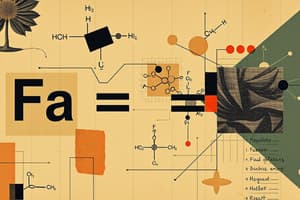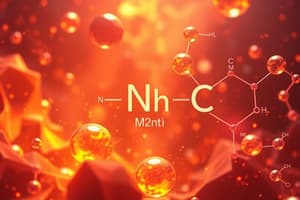Podcast
Questions and Answers
What is the process for naming a binary ionic compound?
What is the process for naming a binary ionic compound?
Name the metal ion, name the non-metal ion ending with 'ide', then write the name of the compound.
What is the chemical formula for Lithium Nitride?
What is the chemical formula for Lithium Nitride?
Li3N
What is the chemical formula for silver oxide?
What is the chemical formula for silver oxide?
Ag2O
What is the chemical formula for silver iodide?
What is the chemical formula for silver iodide?
What is the chemical formula for Calcium Iodide?
What is the chemical formula for Calcium Iodide?
What is the chemical formula for Magnesium Bromide?
What is the chemical formula for Magnesium Bromide?
What is the chemical formula for Rubidium Fluoride?
What is the chemical formula for Rubidium Fluoride?
What is the chemical formula for Aluminum Bromide?
What is the chemical formula for Aluminum Bromide?
What is the chemical formula for Gallium Iodide?
What is the chemical formula for Gallium Iodide?
What is the process for writing the formulas of binary ionic compounds?
What is the process for writing the formulas of binary ionic compounds?
What is the chemical formula for Strontium Nitride?
What is the chemical formula for Strontium Nitride?
What is the chemical formula for Lithium Oxide?
What is the chemical formula for Lithium Oxide?
What is the chemical formula for Silver Sulfide?
What is the chemical formula for Silver Sulfide?
What is the chemical formula for Barium Phosphide?
What is the chemical formula for Barium Phosphide?
What is the chemical formula for Sodium Nitride?
What is the chemical formula for Sodium Nitride?
What does it mean if a metal is considered multivalent?
What does it mean if a metal is considered multivalent?
What is the chemical formula for Copper (I) Nitride?
What is the chemical formula for Copper (I) Nitride?
What is the chemical formula for Iron (II) Phosphide?
What is the chemical formula for Iron (II) Phosphide?
What is the chemical formula for Manganese (II) Oxide?
What is the chemical formula for Manganese (II) Oxide?
What is the chemical formula for Lead (IV) Chloride?
What is the chemical formula for Lead (IV) Chloride?
What is the chemical formula for Iron (III) Phosphide?
What is the chemical formula for Iron (III) Phosphide?
What is the chemical formula for Tin (II) Sulfide?
What is the chemical formula for Tin (II) Sulfide?
What is the chemical formula for Iron (III) Oxide?
What is the chemical formula for Iron (III) Oxide?
What is the chemical formula for Lead (IV) Fluoride?
What is the chemical formula for Lead (IV) Fluoride?
What is the chemical formula for Iron (II) Iodide?
What is the chemical formula for Iron (II) Iodide?
What is the chemical formula for Mercury (II) Iodide?
What is the chemical formula for Mercury (II) Iodide?
What is the chemical formula for Mercury (I) Nitride?
What is the chemical formula for Mercury (I) Nitride?
What is the chemical formula for Tin (IV) Phosphide?
What is the chemical formula for Tin (IV) Phosphide?
A ____________ ion is composed of more than one type of atom joined by covalent bonds.
A ____________ ion is composed of more than one type of atom joined by covalent bonds.
What is the chemical formula for Potassium Acetate?
What is the chemical formula for Potassium Acetate?
What is the chemical formula for Calcium (II) Acetate?
What is the chemical formula for Calcium (II) Acetate?
What is the chemical formula for Ammonium Phosphide?
What is the chemical formula for Ammonium Phosphide?
What is the chemical formula for Ammonium Phosphate?
What is the chemical formula for Ammonium Phosphate?
What is the chemical formula for Aluminum (III) Hydroxide?
What is the chemical formula for Aluminum (III) Hydroxide?
What is the chemical formula for Potassium Chromate?
What is the chemical formula for Potassium Chromate?
Ionic compounds begin with ____________ or _____________.
Ionic compounds begin with ____________ or _____________.
Covalent compounds begin with a ____________ ____________.
Covalent compounds begin with a ____________ ____________.
If the compound is covalent use the __________ naming system.
If the compound is covalent use the __________ naming system.
If the compound is ionic with only one ion charge use __________ __________ __________.
If the compound is ionic with only one ion charge use __________ __________ __________.
If the compound is ionic with more than one ion charge use __________ __________ for the charge.
If the compound is ionic with more than one ion charge use __________ __________ for the charge.
If the compound is ionic, the non-metal atom ends in __________.
If the compound is ionic, the non-metal atom ends in __________.
With polyatomic ions, pay close attention to the __________.
With polyatomic ions, pay close attention to the __________.
Study Notes
Naming Binary Ionic Compounds
- Composed of positive ions (metals) and negative ions (non-metals).
- Name the metal ion first; for example, in CaI2, it is "calcium."
- Rename the non-metal ion by adding the suffix "ide" (e.g., iodine becomes iodide).
- Combine names to form the full compound name (CaI2 = calcium iodide).
Common Binary Ionic Compounds
- Lithium Nitride: Li3N
- Silver Oxide: Ag2O
- Silver Iodide: AgI
- Calcium Iodide: CaI2
- Magnesium Bromide: MgBr2
- Rubidium Fluoride: RbF
- Aluminum Bromide: AlBr3
- Gallium Iodide: GaI3
Writing Formulas for Binary Ionic Compounds
- Identify each ion and its charge before writing formulas.
- Balance the positive and negative charges to determine subscripts.
- For example, aluminum fluoride's formula is AlF3, derived from Al+3 and F-1 charges.
Examples of Binary Ionic Compounds Formulas
- Strontium Nitride: Sr3N2
- Lithium Oxide: Li2O
- Silver Sulfide: Ag2S
- Barium Phosphide: Ba3P2
- Sodium Nitride: Na3N
Multivalent Metals
- Multivalent metals can form ions with different charges (e.g., Nickel has Ni+2 and Ni+3).
- Indicate the charge used in naming with Roman numerals.
- Example: Copper (I) Nitride is Cu3N; its charge is specified as (I).
Examples of Multivalent Metal Compounds
- Iron (II) Phosphide: Fe3P2
- Manganese (II) Oxide: MnO
- Lead (IV) Chloride: PbCl4
- Iron (III) Oxide: Fe2O3
Polyatomic Ions
- Composed of multiple atoms that are covalently bonded and carry a net charge.
- Name the metal ion first, followed by the unchanged name of the polyatomic ion.
- Example: Iron (II) Hydroxide: [Fe(OH)2] is named by identifying Iron (II) and Hydroxide.
Examples of Compounds with Polyatomic Ions
- Potassium Acetate: KCH3COO
- Calcium (II) Acetate: Ca(CH3COO)2
- Ammonium Phosphide: (NH4)3P
- Ammonium Phosphate: (NH4)3PO4
Key Rules for Compound Naming
- Ionic compounds begin with metals or ammonium ions.
- Covalent compounds start with non-metals.
- Use prefixes in covalent naming to indicate the number of atoms.
- For ionic compounds with a single charge, use the metal's name directly; for those with multiple charges, include the charge in Roman numerals.
- Non-metal atoms in ionic compounds end in "ide."
- Be cautious with polyatomic ion names due to similar endings.
Studying That Suits You
Use AI to generate personalized quizzes and flashcards to suit your learning preferences.
Description
Test your knowledge on naming and writing chemical formulas for binary ionic compounds. This quiz will help you understand how to name metal and non-metal ions correctly and combine them to form the right compound names.




